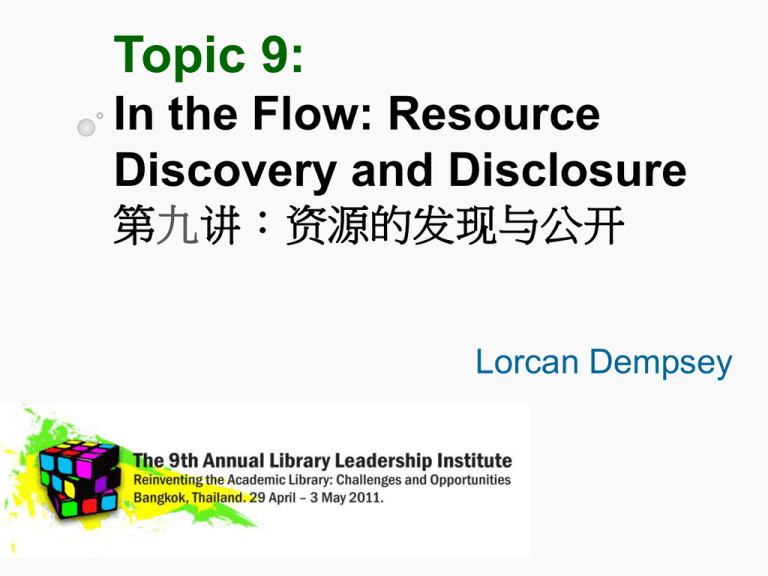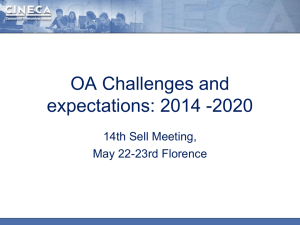Topic 9 In the Flow: Resource Discovery and
advertisement

Topic 9: In the Flow: Resource Discovery and Disclosure 第九讲:资源的发现与公开 Lorcan Dempsey THE UNIVERSITY LIBRARY: in the flow: resource discovery and disclosure 4 Lorcan Dempsey, OCLC Attention switch Then: Resources scarce; attention abundant. Now: Attention scarce; resources abundant. Workflow switch Then: Expect workflows to be built around my service. Now: Build services around workflows “….. mere availability is meaningless ….. “* ….. getting in the flow….. * This Psychologist Might Outsmart the Math Brains Competing for the Netflix Prize http://www.wired.com/techbiz/media/magazine/16-03/mf_netflix?currentPage=1 The power of pull The power of pull We all talk loosely about information overload and assume that this is the real problem. In fact, we live in a world of increasing knowledge scarcity. The most valuable knowledge is in very short supply and is extremely hard to access. Information overload is a distraction. As we discussed in earlier chapters, in a world of accelerating change, the most valuable knowledge is highly distributed and may be embedded in the heads of people who are not well known and who are difficult to identify. [...] Trends U Minnesota Discoverability Users expect discovery and delivery to coincide Usage of portable Internet-capable devices is expanding Users increasingly rely on nontraditional information objects Discovery increasingly happens through recommending Users are discovering relevant resources outside traditional library systems Discoverability Phase 1 final report. http://z.umn.edu/disco1 Findings U Minnesota discoverability Catalogs and web sites still seeing significant use Some evidence of slowing growth in web traffic, usage is shallow Google is the single greatest source of traffic to our sites and applications SFX link resolver is as frequently used as our catalogs or websites More than 75% of requests to SFX originate externally (Google Scholar, PubMed, etc.) Discoverability Phase 1 final report. http://z.umn.edu/disco1 Principles U Minnesota discoverability Discovery should be organized around users rather than collections or systems. This organization should be based on realistic, evidence-based models of our users and their research tasks. Making collections discoverable requires optimizing for access by local and non-local user populations; being good stewards of our collections means participating in cooperative ventures that provide broad access to our collections. Users are successfully discovering relevant resources through nonlibrary systems (e.g., general web searches, e-commerce sites, and social networking applications). We need to ensure that items in our collections and licensed resources are discoverable in non-library environments. Discoverability Phase 1 final report. http://z.umn.edu/disco1 Discovery Not just collections: the full range of what the library has to offer …. Collections Website, repositories, … SEO People, expertise, … Services … Overview Social Being visible in a network environment: the power of pull Discovery and disclosure The website is not the sole focus of attention Social The power of pull Access: the ability to find people and resources when they are needed. Increasingly at the network level. Attract valuable and relevant people and resources to you : Social networking, conferences, location in relevant geographic spikes (Nashville for country music) are important here, as is the ability to be open to and develop relationships through serendipitous encounter. Achieve: learning more effectively and translating that learning into improved performance. The power of pull These people and the knowledge flows they generate can then become effective filters for information more broadly. By harnessing social media such as blogs, social-network platforms, and wikis, we can begin to rely on these mechanisms to expose ourselves to information that has been curated and passed on by these people. Since we deeply understand their contexts and passions, we can begin to determine when their recommendations are most reliable and increase our return on attention for both the tacit knowledge they offer and the information they recommend to us. Our personal social and professional networks will be far more effective in filtering relevant knowledge and information than any broader social-technology tools we might access. social Attract Recommend Build community around social objects (e.g Flickr) Getting into the flow Not just providing a way to interact with resources … … but a way of making yourself visible and attracting resources to you. Flickr commons A good example, however, of increased awareness of the Smithsonian's collections comes from the Smithsonian Libraries' "Portraits of Scientists“ set on Flickr. These photographs of 19th and early 20th century scientists and inventors have been available on the Smithsonian Libraries' website since 2003. Though a popular and cited Web resource, in the three months that the photographs had been on Flickr, they received nearly as many visits as during the previous five years on the Smithsonian site. As an indicator of level of interaction, 55% of photos have comments and 89% have been "favorited". Read more: Rethinking Evaluation Metrics in Light of Flickr Commons | conference.archimuse.com Expertise People are entry points Visibility If the library wishes to be seen as expert then its expertise must be visible Example: ‘indexing’ librarians at U Michigan Attracting .. Professor/Dean Blogs Twitter Youtube iTunes U Student blogs Discovery and disclosure 3 things to look at: 2 modes of discovery and disclosure Direct discovery Library provides discovery services to its resources Indirect discovery Discovery happens elsewhere, so library leverages third party environments to support discovery. Disclosure A new focus on syndication, SEO, APIs, etc, to support new forms of discovery Ithaka S+R Heterick, B. and Hanson, C. Bringing the Library to the User: Integrating Local Web-Scale Discovery Services in ‘Non-Library Provided’ Discovery Points. http://www.cni.org/tf ms/2011a.spring/Abst racts/PB-bringingheterick.html Outside in Bought, licensed Increased consolidation Growth in licensed Move from print to licensed In Many Collection s Licensed Aim: to discover Purchased High Stewardsh ip Inside out Low Stewardsh ip In Few Collection s Institutional assets: special collections, research and learning materials, institutional records, … Increasingly important? Aim: to *have* discovered … Direct discovery Library access to collections Direct Outside in Integrated access to library collections Direct discovery Trend towards integration and the cloud 1. Fragmented: databases, catalog, ….. 2. Metasearch: a layer of integration over distributed resources 3. Discovery layer: centralised index, cloud based Indirect discovery Discovery happens elsewhere … Indirect Attract users to library by being positioned ‘in the flow’ Widgets, apps Resolution, … In the flow .. Variety of workflow tools Network level * * * * * * * * * Mendeley Google Amazon Flickr iTunes Wikipedia Twitter Facebook … * Student portal * Course management system * Reading list * Refworks, … * VIVO, OSU Pro, … * … Build around workflow Remember … Beyond the mobile web. Stephanie Rieger. http://www.slideshare.net/yiibu/beyond-themobilewebbyyiibu LSE Library widgets in Moodle. U Cambridge Sakai based learning management environment. Library widgets. A web index for books? Link through to library resources through Worldcat and other union catalogs Disclosure Make sure that resources are visible in the flow Disclosure and syndication – inside out Institutional assets – website, repositories, … Holdings – knowledge base, catalog (e.g. Google Scholar) Disclosure Effective web presence Strategic content alliance A set of materials to advise on how to create an effective web presence. SEO Metadata Structure etc …. Disclosure External data aggregators fit in to several categories: • General metadata aggregations (examples: WorldCat; Google Scholar; OAIster; Primo Central; Google) • General data object aggregations (examples: HathiTrust; Wikipedia; Internet Archive; Flickr Commons) • Disciplinary aggregations (examples: AgEcon Search; ArXiv (for physics); EarthPrints) • Form aggregations (examples: Digital Dissertations; MERLOT (learning objects); ArtSTOR; ArchiveGrid) • Topical aggregations (examples: Minnesota Reflections; EthicShare) Discoverability Phase 2 Final Report. http://purl.umn.edu/99734 Some directions Attracting …. Social networking strategies for the library Accessing … Think of what discovery tools are effective for particular resources Disclosing … Think of what needs to be done to put resources in the flow Some references Sidorko, P. (October, 2009). Planning for a shared research archive: the Hong Kong experience (PDF) http://www.varastokirjasto.fi/Kuopio3/programme.htm Hagel, J. ., & Singer, M. (January 01, 1999). Unbundling the corporation. Harvard Business Review, 77, 2) Lederman, D. (March 21, 2011). From modernist to modern. Inside Higher Ed. ARL Member Library Profiles. http://www.arl.org/stats/index/profiles/index.shtml Walter, Scott. (January, 2011). “Distinctive Signifiers of Excellence”: Library Services and the Future of the Academic Library. College & Research Libraries, 72:6-8 Hagel, J., Brown, J. S., & Davison, L. (2010). The power of pull: How small moves, smartly made, can set big things in motion. New York: Basic Books Hanson, C. et al. (March 13, 2009) Discoverability Phase 1 Final Report. http://purl.umn.edu/48258 Hanson, C. et al. (February 04, 2011) Discoverability Phase 2 Final Report. http://purl.umn.edu/99734 Ellenberg, J. (January 01, 2008). The Netflix Challenge - A USD million prize for building a better recommendation engine is luring the biggest math brains around. Meet the psychologist who just might outsmart them all. Wired, 16, 3, 114 Heterick, B. and Hanson, C. Bringing the Library to the User: Integrating Local Web-Scale Discovery Services in ‘Non-Library Provided’ Discovery Points. http://www.cni.org/tfms/2011a.spring/Abstracts/PB-bringing-heterick.html






